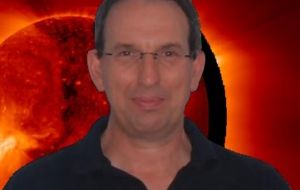MercoPress. South Atlantic News Agency
Lower sunspot activity anticipates chillier winters for northern Europe
 Professor Mike Lockwood from the University of Reading
Professor Mike Lockwood from the University of Reading Periods of low sunspot activity are associated with changes in the winds that tear though the upper atmosphere bringing unusually cold winters to northern Europe, according to the new study Environmental Research Letters
The paper analyzed 350 years of temperature data recorded in central England since 1659, comparing it to astronomical observations of sunspots. The research team, led by Mike Lockwood, a solar-terrestrial physicist at the University of Reading, UK, found that after allowing for global climate change, European winters tended to be 0.5 °C colder than average during low-solar-activity years.
The effect is pronounced enough, he says, that the winter of 2009 was England's 18th coldest in the past 350 years, even though global temperatures were at their fifth highest.
“It is a very careful statistical analysis, which is not the case with all the papers in this particular subject area,” says Joanna Haigh, an atmospheric physicist at Imperial College London. It is less clear why changes in solar activity can affect weather patterns.
Lockwood says that the pattern is related to the effect of ultraviolet light on Earth's stratosphere, located about 20–50 kilometers above the surface. Ultraviolet light from the Sun is absorbed by ozone in the stratosphere, protecting the planet's surface but heating the stratosphere in the process. The effect is largest in the tropics, where sunlight is strongest, and the temperature gradients set up a global pattern of upper-atmosphere winds, including the Northern and Southern Hemisphere jet streams.
“Relatively simple models have demonstrated that heating the equatorial stratosphere can push the jet streams apart just a little bit,” says Lockwood. Similarly, cooling the stratosphere — as occurs during periods of low solar activity — allows the jet streams to shift towards the Equator. This, he says, seems to have a profound effect on European weather by causing the northern jet stream to block warm maritime air from reaching the continent from the Atlantic Ocean. This, in turn, opens the door to cold, northeasterly winds from Russia and the Arctic.
It is a pattern seen in weather records from as far back as 1650–1700, an era known as the Maunder minimum, when the Sun was virtually sunspot-free and 'frost fairs' were held on the River Thames in London. “Early instrumental records show that those cold winters were accompanied by cold winds from the east,” says Lockwood. Similar wind patterns can be deduced from looking at records of wine harvests in Europe, he adds.
Not that these correlations are perfect. “The winter of 1684 was the coldest in the whole record,” says Lockwood. “But the very next year, when solar activity was still low, was the third warmest.”
Part of the variability might be due to factors not taken into account in the paper, suggests Judith Lean, a solar-terrestrial scientist at the US Naval Research Laboratory in Washington DC. For example, she notes that the paper didn't take into account volcanic eruptions, even though these can influence European weather. Still, she says, it is a good study, demonstrating how the complex dynamics of global climate can be 'tweaked' by changes in solar activity.
Lockwood is quick to point out that even if the recent lull in sunspot activity extends into another Maunder minimum, the effects are regional and it will not offset global warming. “This is very much a European phenomenon,” he says.
Still, he says that there is a chance that Europe can expect more chilly winters. “The Sun has been unusually active for the past few decades and is now declining towards average or even low-activity levels,” he says. But he argues that the best way to determine the long-term trend isn't simply to count sunspots. Instead, he says, it is better to look for the changes in the underlying solar magnetic field that drives the flares and sunspots that produce increased levels of ultraviolet activity.
“At each sunspot minimum, the Sun is wiped almost completely clean of spots, which gives the impression that the Sun repeatedly returns to the same low activity state every 11 years or so,” he says. “The solar magnetic field shows that this is not the case and that solar outputs at sunspot minimum can show considerable change.”
Lean disagrees. “I don't think irradiance is any lower now than in prior minima,” she says, adding that the Sun is already beginning a new cycle of activity. Still, she says, “this is all healthy ongoing research”. And, she adds, the basic finding that solar activity influences European winters seems to be spot on.




Top Comments
Disclaimer & comment rulesCommenting for this story is now closed.
If you have a Facebook account, become a fan and comment on our Facebook Page!